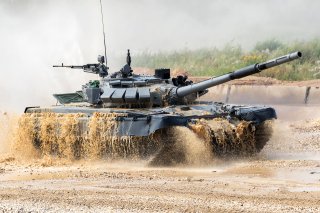Russia’s Turtle Tank is the Stuff of Nightmares
The point of Turtle Tank is to absorb drone attacks when Russian forces are advancing on the front. By absorbing the drone attacks, the Turtle Tanks divert Ukraine’s attention away from other advancing Russian forces that lack the “shell” protections, allowing for those less armored Russian vehicles to move forward in relative safety.
The Ukraine war is doing for the evolution of weapons and tactics in modern war what conflicts like the Spanish Civil War did in the previous century. New ideas and methods of attacks are being experimented with by both sides, forcing rapid adaptations. These changes, in turn, are setting brutal examples for the other great powers in the world as they prepare to wage their next round of war in the near future.
One such wild system that has been deployed by the Russians as a way to overcome the stifling Ukrainian drone threat to Russia’s Main Battle Tanks (MBTs) has been to build what has been nicknamed the “Turtle Tanks.” Looking like some retro machine you’d find in the Amazon series Fallout, the so-called “Turtle Tanks” are essentially steel boxes on tracks with a turret.
The steel box is meant to protect the tank itself from exploding Ukrainian drones.
Just What is a Turtle Tank?
Interestingly, the Turtle Tanks are not entirely new systems. They are merely existing Soviet-era tanks, like the Soviet-era T-62, T-72, and T-80. Russian designers had added improvised steel roofs and siding around the tanks that make the tank look like it is covered by a steel shell—just like how a turtle’s back is covered by a hardened shell that protects it. Metal sheets, corrugated metal, and sometimes even chain-link fences over the tank are welded over the tank to create the “shell.”
Some variants of these tanks have anti-drone slat armor, mine-clearing collars, and electronic warfare (EW) systems to jam drone signals. This transformation has mutated these tanks into massively armored, very slow fortresses. Much like the original “Land Battleship” concept of the earliest tanks that fought in World War I, the “Turtle Tanks” are essentially bulky, slow-moving fortresses.
The point of Turtle Tank is to absorb drone attacks when Russian forces are advancing on the front. By absorbing the drone attacks, the Turtle Tanks divert Ukraine’s attention away from other Russian forces advancing that lack the “shell” protections, allowing for those less armored Russian vehicles to move forward in relative safety. Whenever leading assaults or clearing minefields, these tanks serve as “breachers” or “pioneers,” pushing forward and taking enemy fire to allow for other, specialized units to move in for the kill.
They’re Adapting
Contrary to the rosy predictions of Western media sources and governments, the Turtle Tanks are proof that Russia’s military is rapidly adapting to the combat environment it finds itself in. Thus, the notion that the Russians are failing in the Ukraine war should be viewed with skepticism. Multiple reports from the frontline where these tanks were deployed in combat indicate that the Turtle Tanks can indeed survive multiple drone strikes.
A major problem with the Turtle Tanks, though, is that they are not well-defended against artillery. With so much armor encasing the tanks, artillery is a real problem. If hit with artillery or heavy munitions, the tank is quickly turned into a burning coffin.
Oh, and the adaptations on these tanks listed above significantly limit the tank’s ability to rotate its turret and reduce the visibility for the crew. So, the Russians have been presented with a one-step-forward-two-steps-
The West needs to come to grips with the fact that the Russians, thanks to their greater strategic depth and ability to innovate and adapt to the environment, are likely to win. Systems like the Turtle Tank only show that the Russians are massively adapting to the environment. The Turtle Tanks are ugly and slow, but they get the job done. And that’s what counts.
Brandon J. Weichert, a Senior National Security Editor at The National Interest as well as a Senior Fellow at the Center for the National Interest, and a contributor at Popular Mechanics, consults regularly with various government institutions and private organizations on geopolitical issues. Weichert’s writings have appeared in multiple publications, including the Washington Times, National Review, The American Spectator, MSN, the Asia Times, and countless others. His books include Winning Space: How America Remains a Superpower, Biohacked: China’s Race to Control Life, and The Shadow War: Iran’s Quest for Supremacy. His newest book, A Disaster of Our Own Making: How the West Lost Ukraine is available for purchase wherever books are sold. He can be followed via Twitter @WeTheBrandon.
Image: Degtyaryov Andrey / Shutterstock.com

